WORLD CLASS COACHING
40 Fun Games For Young Players
By Luca Bertolini
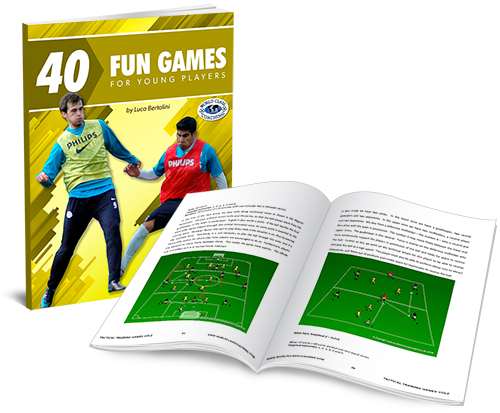
Table of Contents
PART THREE
Fun Games
Fun Games
Exercise 16: tigers zoo (3)
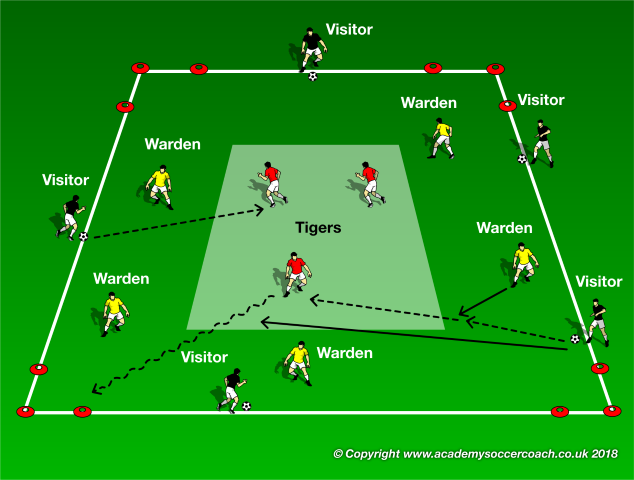
Set-up and sequence: this exercise is the third progression of the number 14. The rectangular set-up is considered as a tigers' zoo. Corner goals are added using red cones as in the picture. The 5 visitors (the players in possession of a ball each) are free to dribble along the border lines of the playing area, 3 red tigers are placed inside another zone in the middle and 5 wardens (defenders) can move freely along the area between the center zone and the border lines, trying to prevent the visitors (attackers) from passing toward the tigers. Each completed pass is a point for the attacking team. If a defender wins the ball, 1 tiger becomes his teammates, as he must pass the ball to the tiger inside the center zone; as the tiger receives, he must dribble the ball out of the nearest and easiest corners gate to gain a point for the defending team. The visitor becomes defender who must recover the space, preventing the tiger from scoring. The tigers must always move to be sure to be unmarked at the back of the wardens or pay attention if they must play together with the wardens.
Coaching points: close the passing lanes, be unmarked at the back, find the right space dribbling the ball, counter-pressing and individual transitions, and defend in an outnumbered situation.
Exercise 17: Tigers Zoo (4)
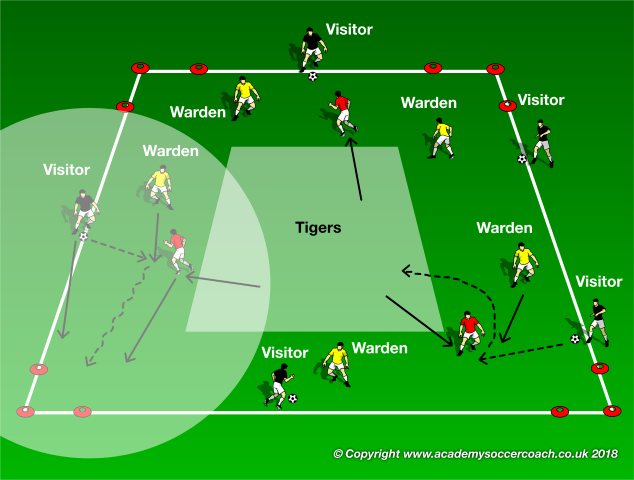
Set-up and sequence: this exercise is the fourth and last progression of the number 14. The rectangular set-up is considered as a tigers' zoo. Corner goals are added using red cones as in the picture. The 5 visitors are free to dribble along the border lines of the playing area, 3 red tigers are placed inside another zone in the middle and 5 wardens (defenders) can move freely along the area between the center zone and the border lines, trying to prevent the visitors (attackers) from passing toward the tigers. Each completed pass is a point for the attacking team; note that in this progression the tigers come run out of the center area to receive and dribble the ball inside, before passing it back. If a defender wins the ball, the tiger becomes visitors' teammate, helping him to recover the possession and avoiding the new ball carrier from dribbling out of the nearest and easiest corners gate to gain a point for the defending team. The visitor becomes defender who must recover the space, preventing the tiger from scoring. The tigers must always move to be sure to be unmarked at the back of the wardens or pay attention if they must play together with the wardens.
Coaching points: close the passing lanes, be unmarked at the back, find the right space dribbling the ball, counter-pressing and individual transitions, double the mark for transition to defend.
Exercise 18: pool soccer
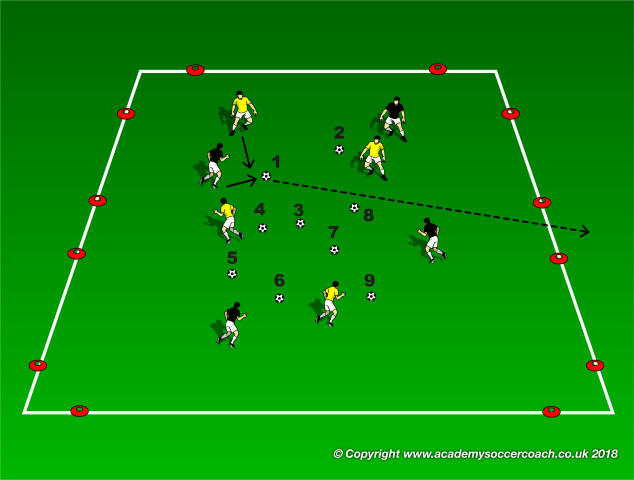
Set-up and sequence: a rectangular area is shaped as a pool table, as the cones' gates are placed as pool holes are (4 on corners and 2 in the middle of the longer sides). 9 numbered balls are placed all over the center part of the set-up. 2 teams of 4 players are free to move without the ball along the space.
The coach calls the number of the ball to be kicked over the easiest cones' line to win 1 point for the momentary possession team, after a 1 v 1 duel; the balls maybe called from 1 to 9 as sequence or randomly. The players involved are the nearest to the ball or decided by the coach, numbering the couples.
Coaching points: quick reaction to win the ball, close the goal space, body placement adaptation to ball and gates to attack and defend.
Exercise 19: shooting range (1)
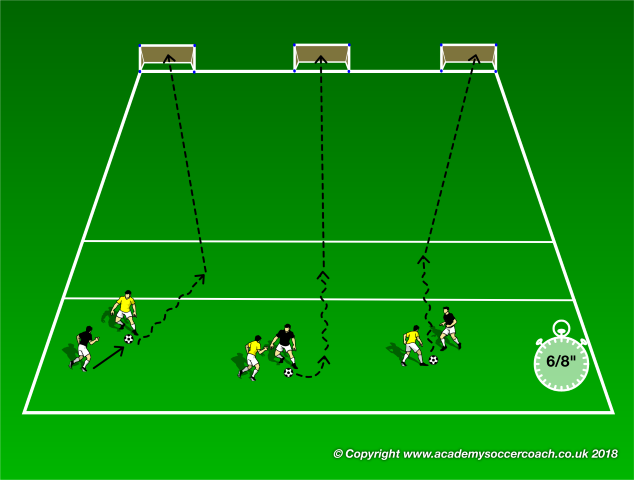
Set-up and sequence: a rectangular area is divided into 3 parts. Multiple 1 v 1 duels are played inside the lower zone (3 in the picture), the middle and shorter zone is where the possession players must shoot on goal from, and the third one that is used to create the distance from the shooting area and the goals placed along the opposite shorter sides. The goals must be the same number of the 1 v 1 duels; the players of the black attacking team have the possession and they must keep it for 6" or 8" after the coach's signal before dribbling inside the short shooting area. The attackers can't score in the same goal and the defenders can't counter the attackers inside the middle area. If the defenders win the ball, before the time limit, the possession must be maintained until the fixed time before dribbling and shooting.
Variation: the defenders can try to defend inside the middle shooting area, but if they win the ball, they must dribble back, maintain the possession as long as the original sequence against the direct opponent, before shooting.
Coaching points: ball protection, tackling to prevent shooting attempts, contrast against an opponent, space closure, counter-pressing to win the ball back.
Exercise 20: shooting range (2)
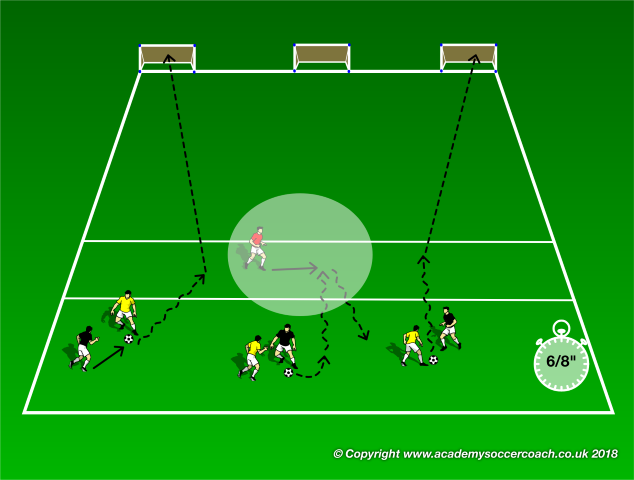
Set-up and sequence: this exercise is a variation of the previous one. A rectangular area is again divided into 3 parts. Multiple 1 v 1 duels are played inside the lower zone (3 in the picture), the middle and shorter zone is where the possession players must shoot on goal from (in this variation against a red player who can counter them) and the third one that is used to create the distance from the shooting area and the goals placed along the opposite shorter sides. The goals must be the same number of the 1 v 1 duels; the players of the black attacking team have the possession and they must keep it for 6" or 8" after the coach's signal before dribbling inside the short shooting area, where red player can counter them. If he wins the ball, the player who loses the possession must replace him. The attackers can't score in the same goal and the defenders can't counter them inside the middle area. If the defenders win the ball, before the time limit, the possession must be maintained until the fixed time before dribbling and shooting, always countered by the red player.
Variation: the defenders can try to defend inside the middle shooting area; this way the red players can choose where to double the mark, if there's more than one 1 v 1 duel in the middle space.
Coaching points: ball protection, tackling to avoid shooting attempts, contrast against an opponent, space closure, counter-pressing to win the ball back, double the mark.
Exercise 21: shooting range (3)
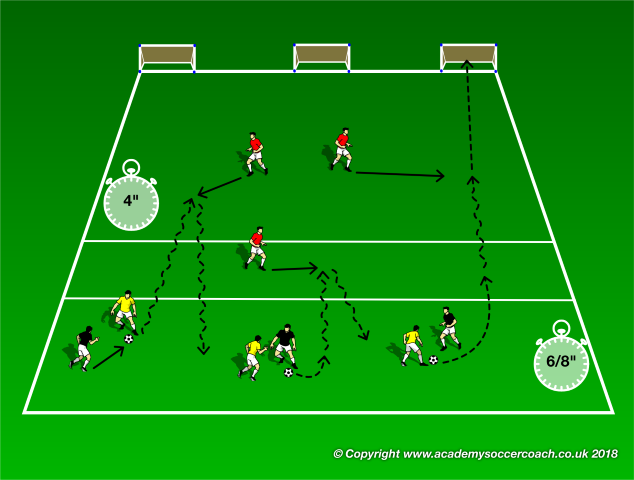
Set-up and sequence: this exercise is another variation of the num.19. A rectangular area is again divided into 3 parts. Multiple 1 v 1 duels are played inside the lower zone (3 in the picture), the middle and shorter zone is where the possession players must dribble through against a red player, who can counter them, and the third one where they must shot on goal being under the pressure of 2 more red players, who try to recover the possession. The goals must be the same number of the 1 v 1 duels; the players of the black attacking team have the possession and they must keep it for 6" or 8" after the coach's signal before dribbling through the middle area, where the first red player can counter them. Then the possession players must run inside the third area, keep the possession for at least 4" before shooting on goal. The attackers can't score in the same goal and the defenders can't counter the attackers inside the middle or third area. If the defenders win the ball, before the time limit, the possession must be maintained until the fixed time, before dribbling and shooting, always under the pressure of the red players, after the black opponents. If the red players win the ball, they switch the roles with the direct opponents.
Coaching points: ball protection, tackling to avoid shooting attempts, contrast against an opponent, space closure, counter-pressing to win the ball back.
Exercise 22: shooting battle (1)
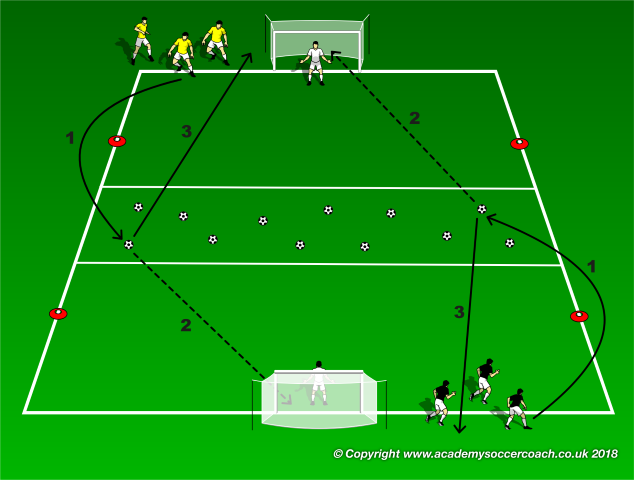
Set-up and sequence: the rectangular playing area is divided into 3 parts and 2 goals with goalkeepers placed in the middle of the shorter sides. An even number of balls (12 in the picture - 2 shots for each player) is placed inside the center area. 4 cones are placed on the left and on the right sides of the outer areas; they must be overcome outwardly, before shooting from the middle area.
The teams (black and yellow) start from the right side of the own goal (or from the left) and they have 6 chances to score (2 for each player); all the players must be quick to gain the best chance to score, kicking the easiest ball, when they run inside the middle area (they can only shot with 1 touch). The next teammate can't start until the prior one is back in line.
Variation: fix a limit of time to shot on goal
Coaching points: sprint ability, changes of direction, coordination to shot on goal with 1 touch.
Exercise 23: shooting battle (2)
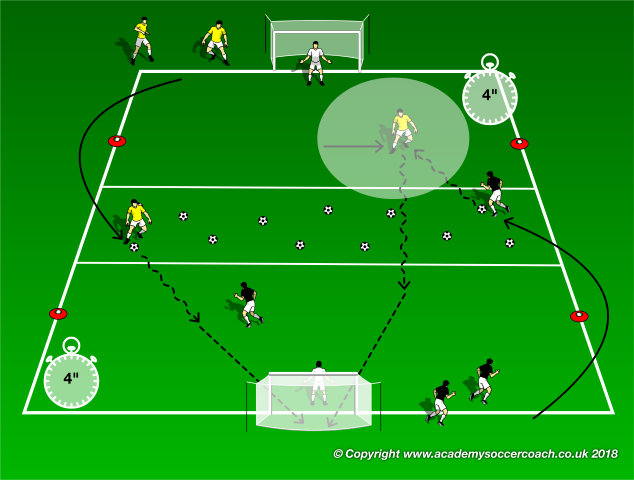
Set-up and sequence: the rectangular playing area is divided into 3 parts and 2 goals with goalkeepers are placed in the middle of the shorter sides. An even number of balls (12 in the picture - 2 shots for each player) is placed inside the center area. 4 cones are placed on the left and on the right sides of the outer areas; they must be overcome outwardly before dribbling the ball out of the center area and shooting inside the final thirds against an opponent. The teams (black and yellow) stars from the right side of the own goal (or from the left) and they have 6 chances to score (2 for each player); all the players must be quick to gain the best chance to score, looking for the easiest ball when they run inside the middle area and dribbling out, as soon as possible to finish. The opponents inside the final thirds have 4" to counter the attackers and win the ball; if they are able to recover the possession, they can shoot freely toward the opposition goal. If they can't recover the ball within that time, then the attackers can't be countered at all. The next teammate can't start until the prior one is back in line.
Coaching points: sprint ability, changes of direction, coordination to shot on goal with 1 touch.
Exercise 24: conquer the cycles
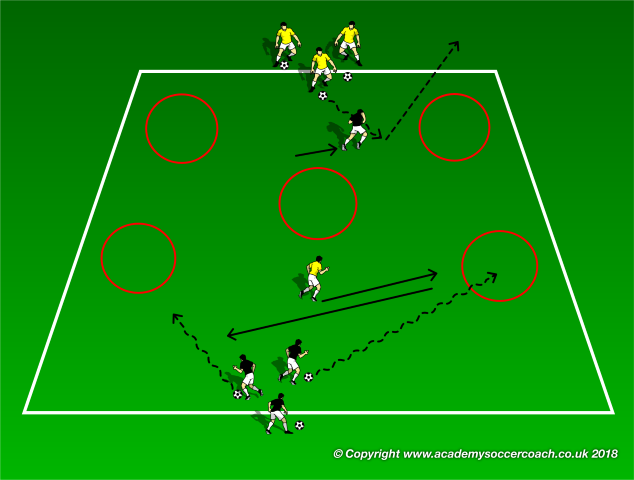
Set-up and sequence: 2 teams of 4 players (3 attackers and 1 defenders) are placed in the middle of the end lines (attackers in possession of a ball each) and in front of the middle 5 cycle set-up (only the defenders). The attackers of each team start dribbling the ball one after the other to "conquer" 1 of the 5 cycles in the middle of the playing area, by placing the ball inside. The defenders must try to prevent the opponents from dribbling inside the cycles, countering and tackling them. The next teammate can't start until the move of the prior one is finished. The team who can conquer 3 cycles wins the round.
Coaching points: dribble the ball at speed, changes of direction while dribbling, counter the opponent directly, quick feints to overcome the direct opponent.
Exercise 25: conquer the cycles and shot on goal (1)
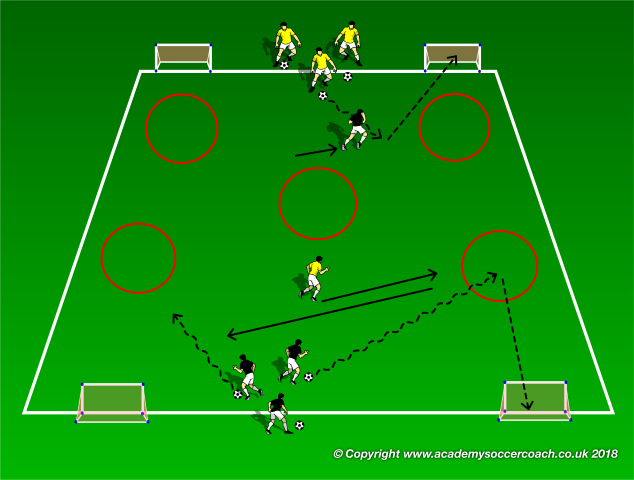
Set-up and sequence: this is a progression of the previous exercise. 2 teams of 4 players (3 attackers and 1 defender) are placed in the middle of the end lines (attackers in possession of a ball each) and in front of the middle 5 cycle set-up (only the defenders). 4 goals are added near the corners along the end lines. The attackers of each team start dribbling the ball one after the other to "conquer" 1 of the 5 cycles in the middle of the playing area, by placing the ball inside, before turning, changing direction and shooting toward the nearest goal. The defenders must try to prevent the opponents from dribbling inside the cycles, countering and tackling them or try to close the space of the potential goal. The team who can conquer 3 cycles and scores wins the round. If the defenders win the ball, they can shot directly toward the nearest goal; if they score, it worth like a conquered cycle.
Coaching points: dribble the ball at speed, changes of direction while dribbling, counter the opponent directly, quick feints to overcome the direct opponent, close the shooting space.
Exercise 26: conquer the cycles and shot on goal (2)
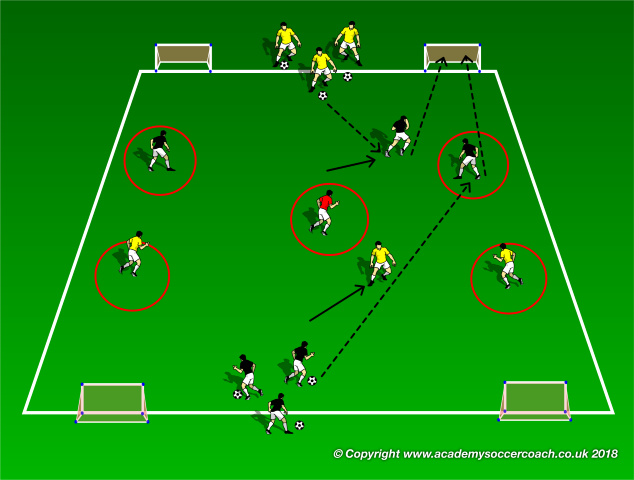
Set-up and sequence: this is a variation of the previous exercise. 2 teams of 6 players (3 dribbling attackers, 2 already placed inside the cycles and 1 defender) are placed inside the rectangular playing area; 4 goals are added near the corners along the end lines. The attackers in possession of each team must be able to pass it to the teammates inside the forward cycles, who must receive and shot with 2 touches; if he scores, the cycle can be considered as conquered. The defenders must try to close the passing lanes. If the possession player is not able to pass directly toward a teammate, the center red free player can help to progress the move; but the following goal worth half point if it is scored. If the defenders win the ball, they can shot directly toward the nearest goal; if they score, it counts like a conquered cycle.
Coaching points: dribble the ball at speed, changes of direction while dribbling, counter the opponent directly, quick feints to overcome the direct opponent, close the shooting space.
Exercise 27: 1 v 1 aerial duels (1)
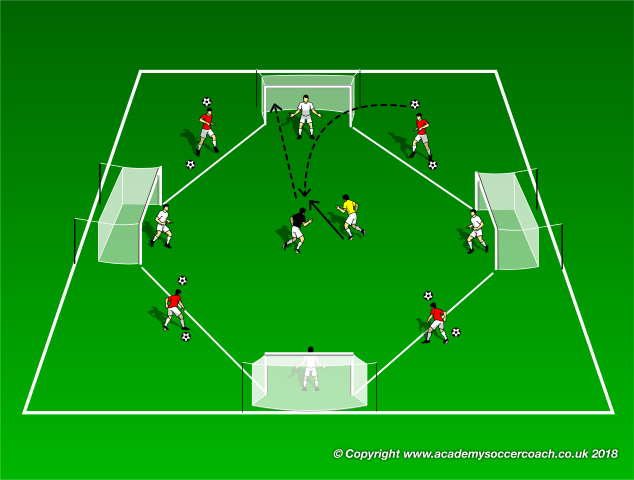
Set-up and sequence: 4 goals with goalkeepers and 4 free players with 2 balls each are placed on the corners and along the sides of a diamond set-up as in the picture. A 1 v 1 duel is played in the middle between the black attacker and the yellow defender; both them can finish 4 times (shooting toward all the goals) and must defend 4 times. The attacker, who must be properly positioned to finish with a header or an aerial shot after a volley pass, decides the free player he wants to receive the pass from. The defender must clear the chances for the opponent by deciding whether to mark him on or save the goal space as best solution.
Variation: the attacking round can be played with 8 balls; 4 aerial passes and 4 ground passes.
Coaching points: body positioning to finish with 1 touch, escape the marker, aerial finishing skills, mark the man on, save the goal space.
Exercise 28: 1 v 1 aerial duels (2)
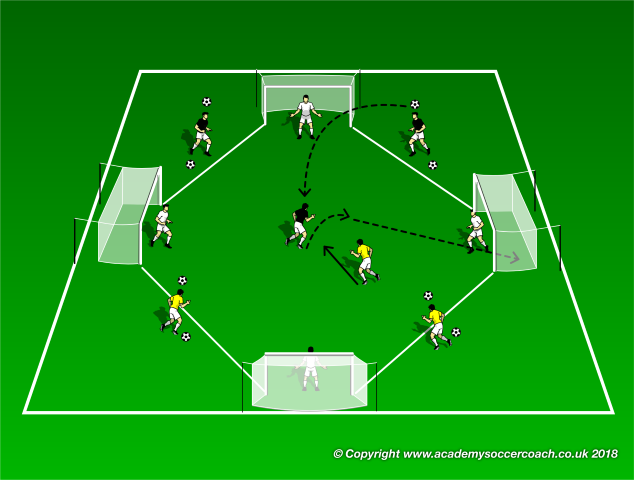
Set-up and sequence: this exercise is a progression of the previous one. 4 goals with goalkeepers and 2 black and 2 yellow players with 2 balls each are placed on the corners, along the sides of a diamond set-up, as in the picture. A 1 v 1 duel is played in the middle between the black attacker and the yellow defender; both them can finish 4 times (shooting toward all the goals) and must defend 4 times, after receiving a pass from the outer teammates. The attacker must be properly positioned to finish with a header or an aerial shot after a volley pass. The defender must clear the chances for the opponent by deciding if to mark him on or saving the goal space as best solution. If the defender wins the ball, he can shoot toward the nearest and easiest goal. The round ends when all the 3 players of each team have played 1 turn as attacker and 1 turn as defender.
Variation: the attacking round can be played with 4 balls; 2 aerial passes and 2 ground passes.
Coaching points: body positioning to finish with 1 touch, escape the marker, aerial finishing skills, mark the man on, save the goal space.


